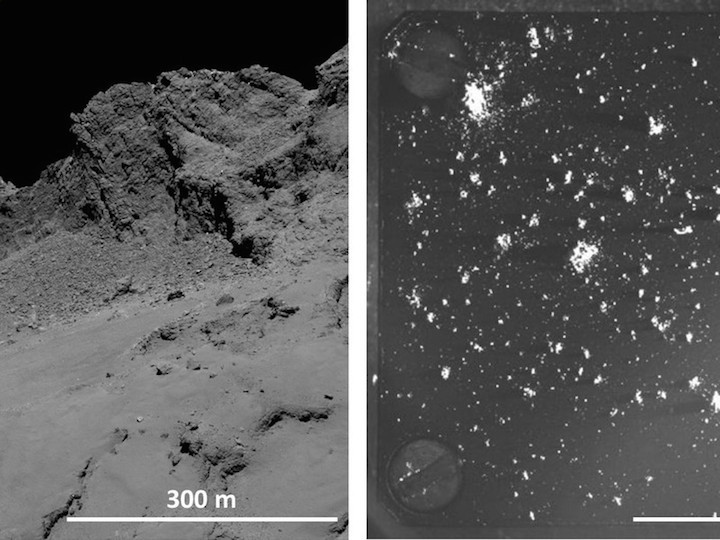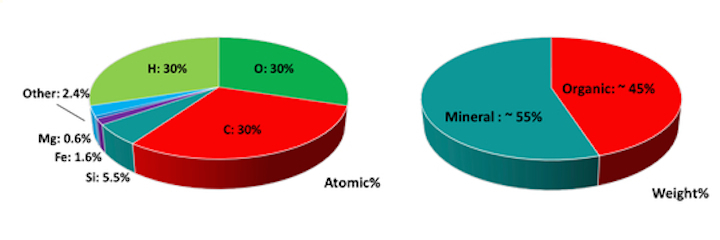3.12.2017
Rosetta: A Comet’s List of Ingredients
For the first time, researchers from the COSIMA team present a quantitative analysis of which chemical elements make up comet 67P/Churyumov-Gerasimenko.
.
When a comet traveling along it highly elliptical orbit approaches the Sun, it becomes active: frozen gases evaporate, dragging tiny dust grains into space. Capturing and examining these grains provides the opportunity to trace the "building materials" of the comet itself. So far, only few space missions have succeeded in this endeavor. These include ESA’s Rosetta mission. Unlike their predecessors, for their current study the Rosetta researchers were able to collect and analyze dust particles of various sizes over a period of approximately two years. In comparison, earlier missions, such as Giotto’s Flyby of comet 1P/Halley or Stardust, which even returned cometary dust from comet 81P/Wild 2 back to Earth, provided only a snapshot. In the case of the space probe Stardust, which raced past its comet in 2004, the dust had changed significantly during capture, so that a quantitative analysis was only possible to a limited extent.
In the course of the Rosetta mission, COSIMA collected more than 35000 dust grains. The smallest of them measured only 0.01 millimeters in diameter, the largest about one millimeter. The instrument makes it possible to first observe the individual dust grains with a microscope. In a second step, these grains are bombarded with a high-energy beam of indium ions. The secondary ions emitted in this way can then be "weighed" and analyzed in the COSIMA mass spectrometer. For the current study, the researchers limited themselves to 30 dust grains with properties that ensured a meaningful analysis. Their selection includes dust grains from all phases of the Rosetta mission and of all sizes.

ESA/Rosetta/MPS for OSIRIS Team MPS/UPD/LAM/IAA/SSO/INTA/UPM/DASP/IDA (left), ESA / Rosetta / MPS for COSIMA Team MPS / CSNSM / UNIBW / TUORLA / IWF / IAS / ESA / BUW / MPE / LPC2E / LCM / IMF / UTU / LISA / UOFC / vH & S. (right)
"Our analyzes show that the composition of all these grains is very similar," MPS researcher Dr. Martin Hilchenbach, Principal Investigator of the COSIMA team, describes the results. The scientists conclude that the comet’s dust consists of the same "ingredients" as the comet’s nucleus and thus can be examined in its place.
As the study shows, organic molecules are among those ingredients at the top of the list. These account for about 45 percent of the weight of the solid cometary material. "Rosetta’s comet thus belongs to the most carbon-rich bodies we know in the solar system," says MPS scientist and COSIMA team member Dr. Oliver Stenzel. The other part of the total weight, about 55 percent, is provided by mineral substances, mainly silicates. It is striking that they are almost exclusively non-hydrated minerals i.e. missing water compounds.

"Of course, Rosetta’s comet contains water like any other comet, too," says Hilchenbach. "But because comets have spent most of their time at the icy rim of the solar system, it has almost always been frozen and could not react with the minerals." The researchers therefore regard the lack of hydrated minerals in the comet’s dust as an indication that 67P contains very pristine material.
This conclusion is supported by the ratio of certain elements such as carbon to silicon. With more than 5, this value is very close to the Sun’s value, which is thought to reflect the ratio found in the early solar system.
The current findings also touch on our ideas of how life on Earth came about. In a previous publication, the COSIMA team was able to show that the carbon found in Rosetta’s comet is mainly in the form of large, organic macromolecules. Together with the current study, it becomes clear that these compounds make up a large part of the cometary material. Thus, if comets indeed supplied the early Earth with organic matter, as many researchers assume, it would probably have been mainly in the form of such macromolecules.
The Max Planck Institute for Solar System Research heads the COSIMA team. The instrument was developed and built by a consortium led by the Max Planck Institute for Extraterrestrial Physics. Other members of the consortium are the Laboratoire de Physique et Chimie de l'Environnement, the Institut d'Astrophysique, the Finnish Meteorological Institute, the University of Wuppertal, the Universität der Bundeswehr, the Research Center Seibersdorf and the Institute for Space Research at the Austrian Academy of Sciences.
+++
Die Zutatenliste des Rosetta-Kometen
Forscher des COSIMA-Teams legen erstmals eine quantitative Analyse vor, aus welchen chemischen Elementen der Komet 67P/Churyumov-Gerasimenko besteht.
-
Wenn sich ein Komet auf seiner stark elliptischen Umlaufbahn der Sonne nähert, wird er aktiv: Gefrorene Gase verdampfen und reißen dabei winzige Staubpartikel mit sich ins All. Diese einzufangen und zu untersuchen, bietet die Möglichkeit, den „Baustoffen“ des Kometen nachzuspüren. Nur wenigen Weltraummissionen ist dies bisher gelungen. Zu ihnen zählt die Rosetta-Mission der europäischen Weltraumagentur ESA. Anders als ihre Vorgänger konnten die Rosetta-Forscher in der aktuellen Studie erstmals Staubkörnchen verschiedenster Größe über einen Zeitraum von etwa zwei Jahren sammeln und analysieren. Frühere Missionen wie etwa Giotto zum Kometen 1P/Halley oder Stardust, die sogar Kometenstaub von 81P/Wild 2 zurück zur Erde brachte, lieferten im Vergleich nur eine Momentaufnahme. Im Fall der Raumsonde Stardust, die 2004 an „ihrem“ Kometen vorbeiraste, hatte sich der Staub beim Einfang zudem stark verändert, dass eine quantitative Analyse nur eingeschränkt möglich war.
Im Verlauf der Rosetta-Mission sammelte COSIMA mehr als 35.000 Staubpartikel. Die kleinsten von ihnen maßen nur 0,01 Millimeter im Durchmesser, die größten etwa einen Millimeter. Das Instrument erlaubt es, die einzelnen Partikel zunächst mit dem Mikroskop zu betrachten. In einem zweiten Schritt werden sie mit einem hochenergetischen Strahl aus Indium-Ionen beschossen. Die so ausgelösten Sekundär-Teilchen lassen sich dann im COSIMA-Massenspektrometer „wiegen“ und analysieren. Für die aktuelle Analyse beschränkten sich die Forscher auf 30 Staubpartikel, deren Eigenschaften sich besonders gut auswerten ließen. Ihre Auswahl umfasst Staubkörnchen aus allen Phasen der Rosetta-Mission und aller Größen.
„Unsere Auswertungen zeigen, dass die Zusammensetzung all dieser Partikel sehr ähnlich ist“, beschreibt MPS-Forscher Dr. Martin Hilchenbach, Leiter des COSIMA-Teams, die Ergebnisse. Die Forscher schließen daraus, dass der Kometenstaub aus denselben „Zutaten“ besteht wie der Komentenkern selbst und somit an seiner statt untersucht werden kann.
Weit oben auf der Zutatenliste stehen laut Studie organische Moleküle. Diese machen etwa 45 Prozent des Gewichts des festen Kometenmaterials aus. „Der Rosetta-Komet gehört damit zu den kohlenstoffreichsten Körpern, die wir im Sonnensystem kennen“, so MPS-Forscher und Mitglied des COSIMA-Teams Dr. Oliver Stenzel. Der andere Teil des Gewichts, etwa 55 Prozent, liefern mineralische Stoffe, hauptsächlich Silikate. Auffällig ist, dass es sich fast ausschließlich um nicht hydrierte Mineralien handelt, also solche, in denen Wasserverbindungen fehlen.
„Natürlich enthält der Rosetta-Komet wie jeder andere Komet auch Wasser“, so Hilchenbach. „Doch weil Kometen die meisten Zeit seit ihrer Entstehung am eisigen Rand des Sonnensystems verbracht haben, war dies fast immer gefroren und konnte nicht mit den Mineralien reagieren.“ Die Forscher betrachten das Fehlen hydrierter Mineralien im Kometenstaub somit als Indiz dafür, dass der Körper ausgesprochen ursprüngliches und unverändertes Material enthält.
Dafür spricht ebenfalls das Verhältnis bestimmter Elemente wie etwa Kohlenstoff zu Silizium. Mit mehr als 5 liegt dieser Wert sehr nahe am Wert der Sonne, in der in etwa die ursprüngliche Gewichtung der Elemente aus den Kindertagen des Sonnensystems erhalten ist.
Die aktuellen Ergebnisse berühren auch unsere Vorstellungen davon, wie das Leben auf der Erde entstand. In einer früheren Veröffentlichung konnte das COSIMA-Team zeigen, dass der Kohlenstoff des Rosetta-Kometen hauptsächlich in Form großer, organischer Makromoleküle vorliegt. Zusammen mit der aktuellen Studie wird deutlich, dass diese Verbindungen einen Großteil des Kometenmaterials ausmachen. Sollten Kometen die frühe Erde tatsächlich mit organischem Material versorgt haben, wie viele Forscher annehmen, wäre dies somit wahrscheinlich hauptsächlich in Form solcher Makromoleküle eingetragen worden.
Das Max-Planck-Institut für Sonnensystemforschung leitet das COSIMA-Team. Das Instrument wurde von einem Konsortium unter der Leitung des Max-Planck-Instituts für Extraterrestrische Physik entwickelt und gebaut. Weitere Mitglieder des Konsortiums sind das Laboratoire de Physique et Chimie de l‘Environnement, das Institut d‘Astrophysique, das Finnische Meteorologische Institut, die Universität Wuppertal, die von Hoerner und Sulger GmbH, die Universität der Bundeswehr, das Forschungszentrum Seibersdorf und das Institut für Weltraumforschung der Österreichischen Akademie der Wissenschaften.
Quelle: MAX-PLANCK-GESELLSCHAFT, MÜNCHEN
